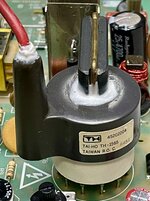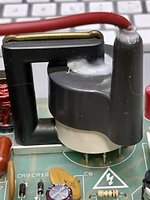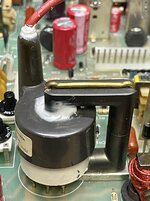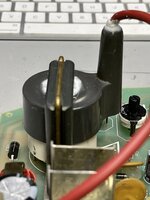I have a few compact Macs where the flyback sealer is pretty dry and cracked looking. Is there a sealer or glue I can use to re-seal it? This one on my Mac Plus (my first computer) looks like it's developed little holes and pits. What is this stuff anyway?

Flyback glue/sealer
- Thread starter reallyrandy
- Start date
You are using an out of date browser. It may not display this or other websites correctly.
You should upgrade or use an alternative browser.
You should upgrade or use an alternative browser.
I have a few compact Macs where the flyback sealer is pretty dry and cracked looking. Is there a sealer or glue I can use to re-seal it? This one on my Mac Plus (my first computer) looks like it's developed little holes and pits. What is this stuff anyway?
I used to think it was epoxy because when you push it with a finger nail nowadays it feels hard as a rock, but people more savvy than me told me it is merely “yellow glue.“ I’ve never been able to determine the exact brand and model number of that glue which was originally used, but clearly it is made for high-voltage flyback applications.
Before you do anything else, my advice is it to determine if you have a problem that really is pertaining to the flyback, and if not, you should just leave things as they are.
Even if you don’t see anything unusual going on with the display content on the CRT when the machine is powered, you can still do one grade test to see if your yellow glue really is cracked or problematic.
Take your Mac, back case removed, into a pitch black room, or wait until it’s late at night so you can ensure no light will enter through windows. Obviously, you’ll need to keep the lights on until you can safely connect the power cord to the machine. Make sure there are no lights at all, not even LED lights, in that room. You will be looking directly at the flyback when you turn off the lights, but it will be pitch dark so make sure you point your eyes at the flyback as you turn off the lights.
It may take a minute for your eyes to adjust once you turn the lights off, but if your flyback is leaking, you will see a very faint blue light coming from the area of the flyback. It’s really faint even in a very dark room. If you see any blue light at all, it is a leak; and in those cases you often can detect an ozone smell too. It is only in that case that you would need to consider applying something to the cracked yellow glue to remedy the problem. But we can discuss details of that after you perform the darkroom test.
If you watch from 15:40 in my video below, you will see the exact darkroom test and blue light I described in my previous post. Keep in mind I boosted the brightness level when editing the video in FCPX. It's actually much harder to see in person.
In that video, I said you probably won't be able to repair it, but since I made that, I found that Silicone Grease (even the type that isn't high-voltage rated) can often do the trick. It remains moist though and can attract dirt and grime as a result, but it does work in many cases, especially on a smaller single-point like (unlike the multi-point leak shown in my video).
In that video, I said you probably won't be able to repair it, but since I made that, I found that Silicone Grease (even the type that isn't high-voltage rated) can often do the trick. It remains moist though and can attract dirt and grime as a result, but it does work in many cases, especially on a smaller single-point like (unlike the multi-point leak shown in my video).
I was waiting for you to post your solution before I said anything.In that video, I said you probably won't be able to repair it, but since I made that, I found that Silicone Grease (even the type that isn't high-voltage rated) can often do the trick. It remains moist though and can attract dirt and grime as a result, but it does work in many cases, especially on a smaller single-point like (unlike the multi-point leak shown in my video).
I had this problem on a mac, in fact after watching JWD's video I now check all of my analog boards in complete darkness as part of my standard induction process for "new" (to me) machines. One had a faint blue glow and upon further inspection I could see the yellow glue was cracked and badly deteriorated.
My solution? I cleaned all of the yellow glue off and use regular old RTV silicone. Seems to be holding up.
Feel free to post an Amazon link to the brand and type you used, Stephen. It also seems you just used a regular kind, not a specialty high voltage kind. No problem with that if your use case has shown it works well over time!I was waiting for you to post your solution before I said anything.
I had this problem on a mac, in fact after watching JWD's video I now check all of my analog boards in complete darkness as part of my standard induction process for "new" (to me) machines. One had a faint blue glow and upon further inspection I could see the yellow glue was cracked and badly deteriorated.
My solution? I cleaned all of the yellow glue off and use regular old RTV silicone. Seems to be holding up.
I read the EEV blog post on this topic and I will do the darkroom test on a few of my older Macs. I'll let you know what I see.
It would be really nice to have a proven way to remedy or even prevent this problem with flybacks. Most of my compacts (128, 512, two pluses) look pretty brown and crusty on their flyback. Preventative maintenance would be great. I await a reply from @Stephen
I do have one Mac plus that had an oily film all over the inside of the case, components, etc. It was concentrated on the anode cap and flyback though. That Mac has no picture although it chimes when booted, so it may be the flyback is shot. I bought another analog board from someone on 68kmla so waiting for it to arrive. I'm wondering if all that oily stuff came from the flyback or the CRT?
It would be really nice to have a proven way to remedy or even prevent this problem with flybacks. Most of my compacts (128, 512, two pluses) look pretty brown and crusty on their flyback. Preventative maintenance would be great. I await a reply from @Stephen
I do have one Mac plus that had an oily film all over the inside of the case, components, etc. It was concentrated on the anode cap and flyback though. That Mac has no picture although it chimes when booted, so it may be the flyback is shot. I bought another analog board from someone on 68kmla so waiting for it to arrive. I'm wondering if all that oily stuff came from the flyback or the CRT?
I'm not surprised about an oily substance on the Anode cap, but "all over the inside of the case" concerns me, especially if by "case" you mean the removable "back plastic case." Could you please post a photo of that?I do have one Mac plus that had an oily film all over the inside of the case, components, etc. It was concentrated on the anode cap and flyback though.
I don't think there's anything particularly special about this brand, but I picked up American Sealant, Inc.'s 502 "High Performance" RTV Silicone locally (Amazon) (Datasheet).Feel free to post an Amazon link to the brand and type you used, Stephen. It also seems you just used a regular kind, not a specialty high voltage kind. No problem with that if your use case has shown it works well over time!
In order to prepare the flyback I carefully cleaned every last speck of yellow glue from the housing and then carefully applied this RTV silicone neatly around where flyback lead connects to the main body of the flyback. I'll try to snap photos later today.
Here are some pics of the anode cap and wire cap before and after cleaning. The same oily substance combined with what looked like soot was all over the back of the CRT and in a very thin layer all over the inside of the Logic board, analog board and inside case. It was almost like it had been owned by a heavy smoker (which it may have).
Here's a link to the original post on 68kmla:
 68kmla.org
68kmla.org


Here's a link to the original post on 68kmla:
Starting a Mac Plus restoration. Need a new flyback wire with anode cap
This poor thing has been in storage since the early 90s. I was gonna use it as a donor Mac but it turns out I don't need any parts from it. So, I decided to try and resurrect it. I plugged it in with my Floppy EMU to try a boot and just got clicking from the PSU (not surprised). I started...
 68kmla.org
68kmla.org
Last edited:
I decided to post this separately to keep it cleaner.
I did the darkroom test and both flybacks are leaking blue. Surprisingly, the one that has no picture (black screen) was only showing a small blue dot (leak) where indicated. This was the oily, sooty one. The caps look really clean on this one but maybe a re-cap will give me a picture back.
The other Mac Plus was leaking blue from several places as indicated in the pics. The CRT on this one is bright and clear. This one has always been in an air conditioned house since I bought it in 1986 so it's still in great shape. This is the most important Mac I have since it was my first computer.


I did the darkroom test and both flybacks are leaking blue. Surprisingly, the one that has no picture (black screen) was only showing a small blue dot (leak) where indicated. This was the oily, sooty one. The caps look really clean on this one but maybe a re-cap will give me a picture back.
The other Mac Plus was leaking blue from several places as indicated in the pics. The CRT on this one is bright and clear. This one has always been in an air conditioned house since I bought it in 1986 so it's still in great shape. This is the most important Mac I have since it was my first computer.
I'd love to see some pics, as I'm sure would JDW too.I don't think there's anything particularly special about this brand, but I picked up American Sealant, Inc.'s 502 "High Performance" RTV Silicone locally (Amazon) (Datasheet).
In order to prepare the flyback I carefully cleaned every last speck of yellow glue from the housing and then carefully applied this RTV silicone neatly around where flyback lead connects to the main body of the flyback. I'll try to snap photos later today.
That's the first time I've seen anything so horribly coating with an unknown substance. But smokers could have caused that. Very possibly! And with all that horrible cancer-causing gunk on your board, it really would need a good cleaning most of all, above and beyond a recap.

@Stephen posted this Amazon link above, so I would recommend giving that a shot to seal the blue-light leak.
As to your other machine with a dark screen (no raster), that can be caused by different things, not just the flyback; and I recommend reading the Video Problems chapter of Larry Pina's excellent Macintosh Repair & Upgrade Secrets.
@Stephen posted this Amazon link above, so I would recommend giving that a shot to seal the blue-light leak.
As to your other machine with a dark screen (no raster), that can be caused by different things, not just the flyback; and I recommend reading the Video Problems chapter of Larry Pina's excellent Macintosh Repair & Upgrade Secrets.
The oily sticky stuff is dielectric grease. It's applied under the anode cap to prevent arcing. If you clean it off, be sure to replace it with new grease.The same oily substance combined with what looked like soot
Good to know. You can pick that stuff up at the auto parts store cheap. It's the same stuff you put on spark plugs, and headlight terminals.
I'm wondering if I could just use that to "plug up the holes" in the flyback yellow glue?
I'm wondering if I could just use that to "plug up the holes" in the flyback yellow glue?
Spoke a little too soon, the Mac Plus that worked great is now taking 3 or 4 minutes to display a picture. It looks clear and bright but the Mac is booted for a few minutes before the screen comes up.

Did you accidentaly do some filming about the procedure? It looks amazing!Here are all four sides of the "resealed" flyback.
View attachment 464View attachment 463View attachment 462View attachment 465
Could you please just explan what exactly you did?
I would like to know "how" did you clean, what are the tricky point at refilling...
I am not an expert of flyback transformers requirements.
How did you clean it? Only physical cleaning or chemical as well? How did you removed the "deeper" pieces...?
What are the main requirements what in case of a resealing need to take in consideration? Electrical isolation, air insulation, visual covering...
Last edited:
But in this case, there is oily black gunk that was all over the place inside, which is clearly something different. Even so, @reallyrandy did show us that he did seem to have cleaned off all the dielectric coating (usually red) that is affixed to the CRT and sits beneath the anode cap...The oily sticky stuff is dielectric grease. It's applied under the anode cap to prevent arcing. If you clean it off, be sure to replace it with new grease.
There has been much debate on that in other forums. Basically, if there are no display anomalies and if there is no noticeable arcing when the machine is in use (voltage leaking out from under the Anode cap), it will not harm anything to use the Mac without the dielectric coating beneath the cap.
Super Corona Dope is one possible replacement solution, but it is expensive, rather deadly according to the label, and high gloss versus the matte finish of the original red substance that was under the cap originally.




